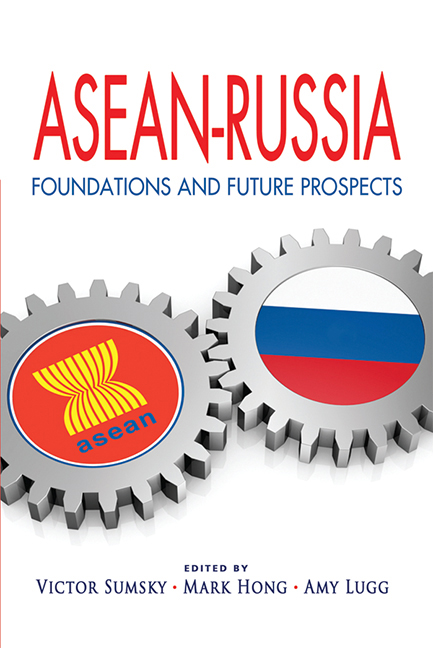Book contents
- Frontmatter
- Contents
- Foreword
- Preface
- About the Contributors
- Keynote Address
- Opening Remarks
- Keynote Address
- Introduction: Russia and the ASEAN Member States: Political and Economic Cooperation in Progress
- SECTION I WISEMEN'S VIEWS
- SECTION II GEOPOLITICS
- SECTION III BILATERAL RELATIONS
- SECTION IV Business and Economics
- SECTION V CULTURE AND EDUCATION
- Credentials of Literature
- A Sentimental Journey through ASEAN (in the Russian Way)
- Food for the Soul and the Stomach
- No Books about Singapore in Russian? Give me a Break! (An Editor's Note)
- National University of Singapore (NUS)-Russia: State of Collaboration
- Soft Power: A Comparison between Britain, France and Russia
- EPILOGUE
- Index
A Sentimental Journey through ASEAN (in the Russian Way)
from SECTION V - CULTURE AND EDUCATION
Published online by Cambridge University Press: 21 October 2015
- Frontmatter
- Contents
- Foreword
- Preface
- About the Contributors
- Keynote Address
- Opening Remarks
- Keynote Address
- Introduction: Russia and the ASEAN Member States: Political and Economic Cooperation in Progress
- SECTION I WISEMEN'S VIEWS
- SECTION II GEOPOLITICS
- SECTION III BILATERAL RELATIONS
- SECTION IV Business and Economics
- SECTION V CULTURE AND EDUCATION
- Credentials of Literature
- A Sentimental Journey through ASEAN (in the Russian Way)
- Food for the Soul and the Stomach
- No Books about Singapore in Russian? Give me a Break! (An Editor's Note)
- National University of Singapore (NUS)-Russia: State of Collaboration
- Soft Power: A Comparison between Britain, France and Russia
- EPILOGUE
- Index
Summary
INTRODUCTION As a professional painter, I strongly believe that my colleagues have something special to contribute to communication between the people. The language of a canvas and a drawing, a sculpture or an ornament needs no translation. Anybody who speaks it well is capable of sending messages which may be profoundly universal and typically local at the same time. A masterful artistic representation of a country, be it your own or a foreign one, will always carry something that a business report or a political review cannot convey — a strong, instantly appealing human sentiment.
AIMS
This is more or less what I felt when in 1991 I was setting up the Bureau of Creative Expeditions in my studio in downtown Moscow. The main idea behind the project was to make Russian art better known in the world and to speak to the Russians about the world in the language of art.
EXPEDITION S AND EXHIBITIONS
Twenty years have passed, and as the Head of the Bureau for all this time, I can say that we have certainly tried to accomplish our task. There have been more than thirty expeditions of Russian artists to such countries as Afghanistan, Cuba, India, Indonesia, Kuwait and Nepal. Pictures and other works of art created during these trips by both acknowledged masters and gifted novices were displayed at scores of exhibitions in these countries. In Moscow and in some other Russian cities similar exhibitions were held in the most prestigious galleries. Catalogues and albums were published, and wide media coverage was there too: the activities of the Bureau have been reported in almost 300 newspaper and magazine articles in Russia and abroad. All these artistic and organizational efforts could not be carried out without close cooperation with many governmental and nongovernmental bodies of Russia — not to mention the sponsors in the countries that we visited.
- Type
- Chapter
- Information
- ASEAN-RussiaFoundations and Future Prospects, pp. 285 - 289Publisher: ISEAS–Yusof Ishak InstitutePrint publication year: 2012



